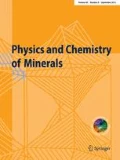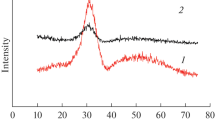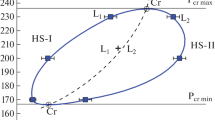Abstract
Pyrochlores, microlites, and U-betafites of pyrochlore group minerals were obtained from mixing experiments of the corresponding oxides and fluorides by hydrothermal synthesis at T = 800 °C and P = 200 MPa in the solution of 1.0 M NaF. The presence of U4+ in pyrochlore does not affect the cell parameter, which for the phases of pyrochlore–microlite series is 10.42 ± 0.01 Å. In a system with an excess of UO2, pyrochlores and microlites, containing uranium up to 0.2–0.3 atoms per formula unit (apfu), are formed. In the uranium-free system of betafites composition, perovskites and Ti-bearing pyrochlores are formed. U-pyrochlores of betafite series, containing 2Ti = Nb + Ta in moles, have cubic cell parameters of 10.26 ± 0.02 Å and U4+ isomorphic capacity of 0.4–0.5 apfu. In the pyrochlore structure, U4+ may substitute for Ca2+ and Na+ cations in the eightfold site. In pyrochlores of pyrochlore–microlite series, Ca2+ is replaced by U4+, while in pyrochlores of betafite series, U4+ replaces Na+. Phases with pyrochlore structure, containing U5+ and U6+ in the sixfold site, usually occupied by Nb5+, Ta5+, and Ti4+, are formed under oxidizing conditions (Cu–Cu2O buffer). They are characterized by low content of Nb5+, Ta5+ (<0.1 apfu), and anomalous behavior of the crystal lattice (compression, instead of expansion). Under natural conditions, the formation of pyrochlores containing a significant amount of U5+ and U6+ is unlikely.















Similar content being viewed by others
References
Allen GC, Crofts JA, Curtis MT, Tucker PM (1974) X-ray photoelectron spectroscopy of some uranium oxide phases. J Chem Soc, Dalton Trans 12:1296–1301. doi:10.1039/DT9740001296
Atencio D, Andrade MB, Christy AG, Gieré R, Kartashov PM (2010) The pyrochlore supergroup of minerals: nomenclature. Canad Mineral 48:673–698. doi:10.3749/canmin.48.3.673
Bera S, Sali SK, Sampath S, Narasimhan SV, Venugopal V (1998) Oxidation state of uranium: an XPS study of alkali and alkaline earth uranates. J Nucl Mater 255:26–33. doi:10.1016/S0022-3115(98)00012-9
Britvin SN, Siidra OI, Krivovichev SV, Depmeier W (2010) Niobate and tantalite pyrochlores: soft synthesis by the fluoride route. Eur J Inorg Chem 2010:1082–1088. doi:10.1002/ejic.200900999
Chadwick D (1973) Uranium 4f binding energies studied by X-ray photoelectron spectroscopy. Chem Phys Lett 21:291–294. doi:10.1016/0009-2614(73)80137-X
Chakhmouradian AR, Mitchel RH (1998) Lueshite, pyrochlore and monazite-(Ce) from apatite-dolomite carbonatite, Lesnaya Varaka complex, Kola Peninsula, Russia. Miner Mag 62:769–782
Chakoumakos BC (1984) Systematics of the pyrochlore structure type, ideal A2B2X6Y. J Sol State Chem 53:120–129. doi:10.1016/0022-4596(84)90234-2
Colella M, Lumpkin GR, Zhang Z, Buck EC, Smith KL (2005) Determination of the uranium valence state in the brannerite structure using EELS, XPS, and EDX. Phys Chem Miner 32:52–64. doi:10.1007/s00269-004-0444-5
Duan N, Tian Zh-R, Willis WS, Suib SL, Newsam JM, Levine SM (1998) Hydrothermal synthesis and structure of a potassium tantalum defect pyrochlore. Inorg Chem 37(4697):4701. doi:S0020-1669(98)00040-8CCC
Finnie KS, Zhang Z, Vance ER, Carter ML (2003) Examination of U valence states in the brannerite structure by near-infrared diffuse reflectance and X-ray photoelectron spectroscopies. J Nucl Mater 317:46–53. doi:10.1016/S0022-3115(03)00004-7
Goh GKL, Haile SM, Levi CG, Lange FF (2002) Hydrothermal synthesis of perovskite and pyrochlore powders of potassium tantalite. J Mater Res 17:3168–3176. doi:10.1557/JMR.2002.0458
He Y, Zhu Y, Wu N (2004) Mixed solvents: a key in solvothermal synthesis of KTaO3. J Solid State Chem 177:2985–2990. doi:10.1016/j.jssc.2004.04.051
Hogarth DD (1977) Classification and nomenclature of the pyrochlore group. Am Mineral 62:403–410
Hogarth DD, Williams CT, Jones P (2000) Primary zoning in pyrochlore group minerals from carbonatites. Miner Mag 64:683–697
Ilton ES, Bagus PS (2011) XPS determination of uranium oxidation states. Surf Interface Anal 43:1549–1560. doi:10.1002/sia.3836
Kerr PF, Holmes RJ (1945) X-ray study of the tantalum mineral simpsonite. Bull Geol Soc Am 56:479–504
Kotelnikova ZA, Kotelnikov AR (2008) NaF-bearing fluids: experimental investigation at 500–800 °C and P = 2000 bar using synthetic fluid inclusions in quartz. Geochem Int 46:48–61. doi:10.1134/S0016702908010047
Kumada N, Ozawa N, Kinomura N, Muto F (1985) Preparation of pyrochlores. A1−xHxTaO3·nH2O (A = Na, K). Mater Res Bull 20:583–589
Lewandowski JT, Pickering IJ, Jacobson AJ (1992) Hydrothermal synthesis of calcium—niobium and tantalum oxides with the pyrochlore structure. Mater Res Bull 27:981–988. doi:10.1016/0025-5408(92)90199-A
Lumpkin GR, Ewing RC (1988) Alpha-decay damage in minerals of the pyrochlore group. Phys Chem Miner 6:2–20
Lumpkin GR, Ewing RC (1995) Geochemical alteration of pyrochlore group minerals: pyrochlore subgroup. Am Mineral 80:732–743
Lumpkin GR, Ewing RC (1996) Geochemical alteration of pyrochlore group minerals: betafite subgroup. Am Mineral 81:124–1237
Lumpkin GR, Ewing RC, Williams CT, Mariano AN (2001) An overview of the crystal chemistry, durability, and radiation damage effects of natural pyrochlore. Mat Res Soc Symp Proc 663:921–934
Mercier-Bion F, Drot R, Ehrhardt JJ, Lambert J, Roques J, Simoni E (2011) X-ray photoreduction of U(VI)-bearing compounds. Surf Interface Anal 43:777–783. doi:10.1002/sia.3617
Pekov IV, Grigorieva AA, Turchkova AG, Lovskaya EV (2008) In: Krivovichev S (ed) Minerals as advanced materials 1. Springer, St. Petersburg. ISBN 978-3-540-77122-7, e-ISBN: 978-3-540-77123-4
Pointeau V, Deditius AP, Miserque F, Renock D, Becker U, Zhang J, Clavier N, Dacheux N, Poinssot C, Ewing RC (2009) Synthesis and characterization of coffinite. J Nucl Mater 393:449–458. doi:10.1016/j.jnucmat.2009.06.030
Ratnamala A, Suresh G, Kumari VD, Subrahmanyam M (2008) Template synthesized nano-crystalline natrotantite: preparation and photocatalytic activity for water decomposition. Mater Chem Phys 110:176–179. doi:10.1016/j.matchemphys.2008.01.039
Redkin AF, Borodulin GP (2010) Pyrochlores as indicators of the uranium potential of magmatic melts. Doklady Earth Sci 432:787–790. doi:10.1134/S1028334X10060176
Redkin AF, Redkina LP (1988) Way of dissolution of the uranium oxides. Author’s certificate on invention no 144337 from 8.08.1988 on the application no 4160414 with the priority from 10.11.1986
Ribalov BL, Omelyanenko BI (1989) The sources of ore substance of the endogenic uranium ore deposits. Nauka, Moscow (in Russian)
Shannon RD (1976) Revised effective ionic radii and systematic studies of interatomic distances in halides and chalcogenides. Acta Cryst A32:751–767. doi:10.1107/S0567739476001551
Smirnova OA, Kumada N, Yonesaki Y, Kinomura N (2008) A new solid electrolyte to fill the gap between low temperatures nad high temperatures SOFC materials? Electrochem Comm 10:485–487. doi:10.1016/j.elecom.2008.01.016
Teterin YA, Kulakov VM, Baev AS, Nevzorov NB, Melnikov IV, Streltsov VA, Mashirov LG, Suglobov DN, Zelenkov AG (1981) A study of synthetic and natural uranium oxides by X-ray photoelectron spectroscopy. Phys Chem Miner 7:151–158
Yaroshevskii AA, Bagdasarov YA (2008) Geochemical diversity of minerals of the pyrochlore group. Geochem Int 46:1245–1266. doi:10.1134/S0016702908120045
Acknowledgments
This work was supported by the research grant RFBR no 11-05-01185-a and the Program of the Earth Sciences Branch of the Russian Academy of Sciences, ONZ no 2. The authors grateful Alexey Nekrasov, Gleb Borodulin, Tatyana Dokina, and Olga Samokhvalova for the help in the investigations and Dr. Hongsheng Cao for editorial assistance and constructive comments on the paper. The authors thank the anonymous reviewers for providing constructive criticism and helpful comments on previous version of the manuscript; these considerably improved the paper.
Author information
Authors and Affiliations
Corresponding author
Rights and permissions
About this article
Cite this article
Redkin, A.F., Ionov, A.M. & Kotova, N.P. Hydrothermal synthesis of pyrochlores and their characterization. Phys Chem Minerals 40, 733–745 (2013). https://doi.org/10.1007/s00269-013-0608-2
Received:
Accepted:
Published:
Issue Date:
DOI: https://doi.org/10.1007/s00269-013-0608-2




